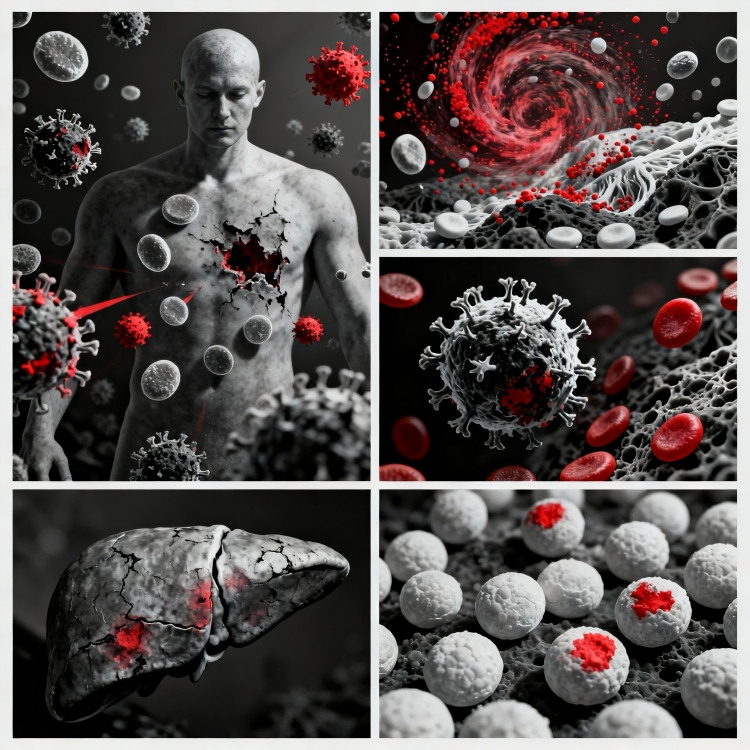
Dr. Venkatesh BS: The Enigma of Hemophagocytic Lymphohistiocytosis
Dr Venkatesh BS, Transplant Surgeon at CareVue Health, posted on LinkedIn:
”When the Immune System Turns on Itself: The Enigma of HLH
Few conditions blur the line between inflammation and devastation like Hemophagocytic Lymphohistiocytosis (HLH), a hyperinflammatory syndrome where the immune system turns upon itself.
Originally described in the 1950s as “familial hemophagocytic reticulosis,” HLH is now recognized across all ages either genetic (primary) or acquired (secondary), often triggered by viral infections, malignancies or autoimmune flares.
Cytotoxic T cells and macrophages go rogue, releasing massive amounts of cytokines (IFN-γ, IL-6, TNF-α), leading to fever, cytopenias, hyperferritinemia and multi-organ injury.
The liver is a frequent target, sometimes culminating in acute liver failure (ALF).
Clinical Presentation: When Every Organ Suffers
HLH is the great masquerader.
- Persistent high fever unresponsive to antibiotics
- Hepatosplenomegaly, cytopenias, elevated ferritin (often >10,000!)
- Transaminitis, coagulopathy, hypertriglyceridemia, hypofibrinogenemia
- Neurological symptoms or acute liver failure may occur in advanced stages
For hepatologists and transplant teams, HLH presenting as fulminant hepatic failure is a diagnostic minefield often mistaken for viral or autoimmune hepatitis.
When HLH Meets Liver Failure
HLH-associated ALF is one of the most challenging diagnostic and therapeutic dilemmas.
When unresponsive to immunosuppressive therapy (dexamethasone, etoposide, ruxolitinib), liver transplantation (LT) becomes a potential life saving bridge, provided the cytokine storm has subsided and systemic inflammation is controlled.
Liver Transplant in HLH: The Tightrope
When to Consider Liver Transplant in HLH
- Fulminant hepatic failure
- Irreversible hepatic necrosis with recovery of systemic inflammation.
- Post infection or post immune HLH where the cytokine storm has been controlled.
- Post chemotherapy hepatic failure in malignancy associated HLH.
Timing is critical!! transplant too early, and the hyperinflammatory state destroys the graft; too late, and multi-organ dysfunction sets in.
Post-transplant care demands balancing immune suppression vs immune dysregulation:
- Minimize calcineurin inhibitors early; rely on steroids or targeted cytokine blockers.
- Monitor ferritin, IL-2 receptor, and viral markers for relapse.
- Consider emapalumab or ruxolitinib if hypercytokinemia recurs.
When timed right and tailored well, LT can achieve excellent outcomes, not just organ replacement but immune recalibration.
HLH teaches us a profound lesson:
The immune system, when unrestrained, can be both healer and destroyer and the art of transplant medicine lies in restoring that delicate balance.
Have you encountered HLH presenting as acute liver failure or post transplant immune dysregulation?
Would love to hear your thoughts.”

Stay informed with Hemostasis Today.
-
Oct 28, 2025, 14:27Maha Othman on 10-Year Anniversary of the CanVECTOR Research Network!
-
Oct 28, 2025, 14:00Claudio Laudani on PCSK9 Association with Increased Platelet Reactivity: A Pooled Analysis
-
Oct 28, 2025, 13:31Laurent Bertoletti Invites You to The INNOVTE and GITA Joined Meeting on Hormones and Thrombosis
-
Oct 28, 2025, 12:28Courtney Lawrence: Honored to Team Up with BET on Blood at AABB 2025
-
Oct 27, 2025, 19:45Benedikt Lorenz on Liver Failure and Coagulation – Myths, Traps, and Bad Habits
-
Oct 28, 2025, 13:09Gregory Piazza on CORONA-VTE Network Analysis
-
Oct 27, 2025, 18:42Khaled Musallam Shares BEYOND Trial Phase 2 Insights on Luspatercept Use in NTD β-Thalassaemia
-
Oct 27, 2025, 13:30Fabrice Cognasse: When Platelets Meet Artificial Intelligence!
-
Oct 27, 2025, 13:00Hossam El Benawi Shares Multi Site LVT Study from Mayo Clinic
-
Oct 27, 2025, 08:01Acquired Hemophilia A (AHA) is Rare and Often Missed - RPTH Journal
-
Oct 25, 2025, 07:42Adithya Hande: India’s Silent Killer and a Scientific Breakthrough
-
Oct 23, 2025, 09:57Arun V. J: Artificial Blood Is Closer Than You Think
-
Oct 23, 2025, 07:11Sebastien Lobet Presented the ACTIVLIM-Hemo Scale
-
Oct 23, 2025, 07:05Syed Ehsan Shah on Advantages of Werfen HemoCell Automation
-
Oct 22, 2025, 08:25Johanna Nystedt: Not Every Day We Can Release a New Blood Product to Meet An Unmet Medical Need!
-
Oct 27, 2025, 15:10David McIntosh: Making Measurable Progress – Towards a World in Which No-one Ever Dies from Lack of a Vital Plasma-Derived Medicine
-
Oct 27, 2025, 13:18Stroke Foundation Welcomes Jacqui McCallum as the New Executive Director
-
Oct 27, 2025, 12:54Guillermo Lahera Forteza on Stroke and Mental Health
-
Oct 27, 2025, 12:37Joshua Ngimbwa Recognised as the Best Male Junior Investigator Awardee at the Tanzania Health Summit
-
Oct 27, 2025, 08:00Rohit Gosain: Revumenib is Now FDA Approved for R/R AML with NPM1 Mutation
